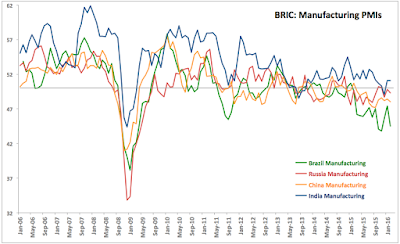As global manufacturing sector activity barely stayed above the recession line in 4Q 2019, BRICs manufacturing PMIs indicated a cautious upswing in activity, with exception for Russia and India. Here are the core details:
- Brazil's 4Q 2019 Manufacturing PMIs averaged 51.8, statistically unchanged on 3Q 2019 figure of 51.9. Both 3Q and 4Q readings were statistically above 50.0, indicating modest growth, and above historical average of 50.3. Nonetheless, 4Q 2019 reading was the second lowest in six consecutive quarters.
- Russia posted its second consecutive quarter of recessionary growth readings for manufacturing sector, with quarterly average PMI slipping to 46.8 in 4Q 2019, down from 48.2 in 3Q 2019, making 4Q contraction the sharpest since 2Q 2009. All in, the last time Russian manufacturing sector posted statistically above 50.0 reading was in 1Q 2019. The signal here is severely negative to overall growth prospects for the Russian economy for the entire 2019 and a major concern for the 1H 2020 dynamics.
- China manufacturing PMI surprised to the upside in the last quarter of 2019, rising from 50.6 in 3Q 2019 (a reading statistically indistinguishable from zero growth 50.0 mark) to 51.7 in 4Q 2019 (a reading indicating moderate expansion, compared to the historical average of 50.8). Statistically, Chinese manufacturing has not been in an expansion mode over 3Q 2018 - 3Q 2019 period, which makes 4Q 2019 reading an important signal of a potential turnaround.
- India manufacturing PMI averaged 51.5 in 4Q 2019, slightly down on 51.8 in 3Q 2019. This is the weakest level since 3Q 2017, but statistically it is still indicative of expansion in the sector.
Overall, BRIC Manufacturing PMI (based on each country share in global GDP) has improved from 50.7 in 3Q 2019 to 51.2 in 4Q 2019, marking the fastest rate of the group's manufacturing sector expansion 1Q 2018 and the second consecutive quarter of the index being statistically above the 50.0 zero growth line.
Globally, manufacturing sector growth conditions improved from 49.5 in 3Q 2019 to 50.1 in 4Q 2019, although statistically, no reading from 2Q 2019 onwards was significantly above or below the zero growth 50.0 line.
As the chart above clearly shows, Global Manufacturing sector activity remains extremely weak. On-trend, more recent BRICs Manufacturing sector growth is above that of the Global PMI signal, but both show weaknesses.
































